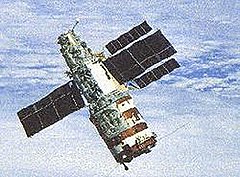
Back ساليوت 7 (مركبة فضائية) Arabic Salyut 7 Azerbaijani Салют-7 Bulgarian Saliut 7 Catalan Saljut 7 Czech Saljut 7 German Saliut 7 Spanish Saliout 7 French Saliut 7 Galician סאליוט 7 HE
 Salyut 7 photographed by Soyuz T-13 crew before docking, 25 September 1985 | |
 The insignia of the Salyut Program | |
| Station statistics | |
|---|---|
| COSPAR ID | 1982-033A |
| SATCAT no. | 13138 |
| Launch | 19 April 1982, 19:45:00 UTC |
| Carrier rocket | Proton-K No. 306-02 |
| Launch pad | Baikonur, Site 200/40 |
| Reentry | 7 February 1991[1] |
| Mass | 19,824 kg (43,704 lb) |
| Length | 16 m (52 ft) min.[1] |
| Width | 4.15 m (13.6 ft) max.[1] |
| Pressurised volume | 90 m3 (3,200 cu ft) min.[1] |
| Periapsis altitude | 219 km (136 mi; 118 nmi) |
| Apoapsis altitude | 278 km (173 mi; 150 nmi) |
| Orbital inclination | 51.6° |
| Orbital period | 89.21 minutes |
| Days in orbit | 3,215 days |
| Days occupied | 816 days |
| No. of orbits | 51,917 |
| Distance travelled | 2,106,297,129 km (1,137,309,460 nmi) |
| Statistics as of de-orbit and reentry | |
| Configuration | |
 Salyut 7 with docked Kosmos 1686 TKS spacecraft | |
Salyut 7 (Russian: Салют-7, lit. 'Salute 7'), also known as DOS-6 (Durable Orbital Station 6)[1] was a space station in low Earth orbit from April 1982 to February 1991.[1] It was first crewed in May 1982 with two crew via Soyuz T-5, and last visited in June 1986, by Soyuz T-15.[1] Various crew and modules were used over its lifetime, including 12 crewed and 15 uncrewed launches in total.[1] Supporting spacecraft included the Soyuz T, Progress, and TKS spacecraft.[1]
It was part of the Soviet Salyut programme, and launched on 19 April 1982 on a Proton-K rocket from Site 200/40 at the Baikonur Cosmodrome in the Soviet Union. Salyut 7 was part of the transition from monolithic to modular space stations, acting as a testbed for docking of additional modules and expanded station operations. It was the eighth space station of any kind launched. Salyut 7 was the last of both the second generation of DOS-series space stations and of the monolithic Salyut Program overall, to be replaced by Mir, the modular, expandable, third generation.